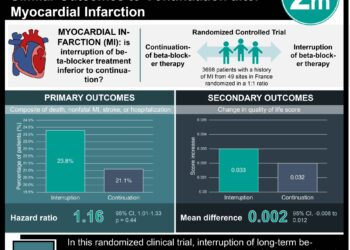Systemic beta-blockers and nitrates linked to lower intraocular pressure
Image: PD
1. Both ß-blockers (-0.92 mmHg, p<0.001) and nitrates (-0.63 mmHg, p=0.011) were associated with a significantly lower intraocular pressure.
2. Statins and aspirin were initially associated with lower intraocular pressure, but were found to be due to concurrent use of ß-blockers.
Evidence Rating Level: 2 (Good)
Study Rundown: In this study, a large European patient database was used to identify whether any systemic medication classes were correlated with decreased intraocular pressure (IOP). The authors found that 2 specific classes were associated with a significantly lower IOP – ß-blockers (-0.92 mmHg, p<0.001) and nitrates (-0.63 mmHg, p=0.011). The use of ß-blockers has been previously associated with a reduced risk of glaucoma. Strengths of the study include the large patient database. Limitations in this study include the use of a noncontact tonometer for IOP measurement (instead of the gold standard of Goldmann tonometry), as well as patient medication list being self-reported. In addition, it is unclear whether the absolute IOP difference of ~1 mmHg in patients on these medications will have a large clinical impact. Nonetheless, this is the first study to link nitrates to decreased IOP, and reaffirms the impact of systemic ß-blocker therapy. The study is also the first to disprove an association between statins and decreased IOP, which had been previously reported. This study suggests that ophthalmologists should be aware of the impact of patients’ medication lists.
Click to read the study in Ophthalmology
Relevant Reading: Systemic antihypertensive medical and incident open-angle glaucoma
In-Depth [cross-sectional study]: Over 7,000 Europeans from the EPIC patient database were studied. IOPs of both eyes were measured using noncontact tonometry and averaged. All patients self-reported their medication lists. Medication classes that were reviewed included ACE inhibitors, ARBs, ß-blockers, CCBs, diuretics, nitrates, statins, aspirin, insulin, other antiglycemics, and other NSAIDs. Multivariate regression models were created to assess for associations between medication and IOP after adjustment for age, gender, hemoglobin A1c levels, and BMI. After removal of confounders, the use of ß-blockers and nitrates were independently associated with decreased IOP. The association remained even when adjusted for blood pressure and heart rate. Statin and aspirin use was also found to have a significant association with IOP, but was due to concurrent ß-blocker use. These data may be important to consider when an ophthalmologist is considering ocular antihypertensive therapy.
More from this author: Argus II retinal prosthesis significantly improves spatial vision in blind patients, Artificial cornea is well retained in patients with ocular surface disease, High prevalence of undiagnosed glaucoma in West Africa, Interferon therapy is superior to methotrexate for uveitis, Rho kinase inhibitor safely reduces intraocular pressure
©2012-2014 2minutemedicine.com. All rights reserved. No works may be reproduced without expressed written consent from 2minutemedicine.com. Disclaimer: We present factual information directly from peer reviewed medical journals. No post should be construed as medical advice and is not intended as such by the authors, editors, staff or by 2minutemedicine.com. PLEASE SEE A HEALTHCARE PROVIDER IN YOUR AREA IF YOU SEEK MEDICAL ADVICE OF ANY SORT.

![2 Minute Medicine: Pharma Roundup: Price Hikes, Breakthrough Approvals, Legal Showdowns, Biotech Expansion, and Europe’s Pricing Debate [May 12nd, 2025]](https://www.2minutemedicine.com/wp-content/uploads/2025/05/ChatGPT-Image-May-12-2025-at-10_22_23-AM-350x250.png)





